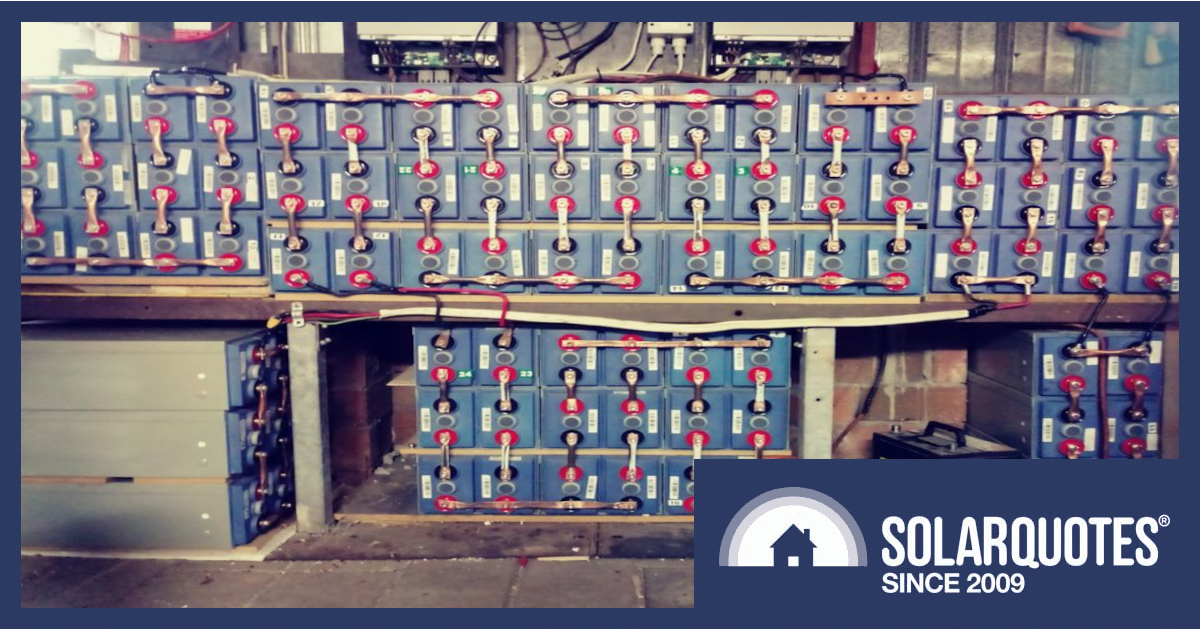
We recently polled installers in the SolarQuotes network to discover their favourite home batteries. Tesla, Sungrow and BYD batteries took the podium.
This post looks a little deeper into the winning brands from an experienced battery installer’s perspective.
Tesla
Powerwall: the Hoover of home batteries.
There are a few daily items that adopt a trade name as a generic descriptor. In England, it was Hoover that lent their name to vacuuming your house. In Australia, it was Malleys Esky that became the ubiquitous name for any ice box you travelled with. I’m not making any promises, but household battery storage seems to have adopted a trade name too.
There are DIY groups for making your own Powerwall, while inverter manufacturer Sofar have decided to wave their red cape at Tesla’s bullish legal department by calling its white stack of batteries a “Powerall”.
Tesla has a simple home battery solution. There’s one model, it’s shiny white and does what it says on the tin. There’s a nice clean app and if you want more, they can be stacked. From a superficial consumer perspective, they’re an attractive piece of kit.
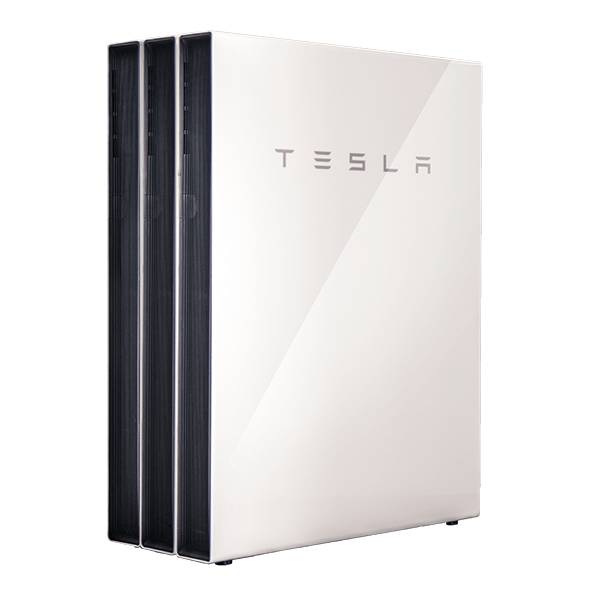
3 stacked Powerwalls
Thankfully there’s some substance to Tesla Powerwall too. They pack a good amount of storage and surge capacity to back up loads when the grid goes down, as well as compatibility with various VPPs and third-party apps.
From an installer’s perspective, the Powerwall offers something priceless: a lack of problems. They are straightforward to set up, the gateway offers space for cable, circuit breakers and decent-sized terminations. Legacy solar can be monitored remotely with wireless neurio devices.
Of the installers I have spoken to, they say they’ve had a handful of problems, and most of those have been remotely diagnosed by Tesla themselves, who then send their own technicians to make good. It will be interesting when Tesla releases their own solar inverter in Australia.
The Powerwall’s Achilles Heel
AC coupled batteries are easy to retrofit because they have their own inverter. But that inverter can count toward the total inverter capacity your Distributed Network Service Provider (DNSP) allows. Why does it matter? You can have all the storage you want, but without surplus solar energy to charge it, the capital and energy invested won’t pay off anytime soon.
For example, if you have a single-phase house, 5kW of legacy solar system, and a 10kW ceiling imposed by the DNSP :
Scenario 1
- a 5kW Powerwall uses half your connection capacity
- a 5kW solar inverter takes up the balance
- That inverter can have 133% overdrive; i.e. 6.6kW of solar PV
- 150% or 200% is not available without forgoing upfront incentives because, technically an AC-coupled battery means the system is not eligible for STCs on full manufacturer solar capacity.
Scenario 2
- A 5kW solar inverter is half the connection capacity, with 6.6kW of solar PV
- A 5kW DC coupled hybrid inverter is installed for the balance
- Depending on manufacturer specification, that hybrid can have 7.5 or 10kW of solar PV, with STCs paid on the solar.
- If a compatible AC coupled solar inverter is used with the hybrid system, a further 0.9 to 3.4kW of solar can be added
- Grand total of 20kW of solar may be possible, with greater surge capacity under blackout conditions when the sun is up
I have never met a customer who complained they installed too much solar.
Sungrow
Winning friends and influencing installers.
The latest, 3rd generation high voltage Sungrow hybrids will also work with AC coupled solar inverters operating on the backup circuit, which means more solar and surge capacity. There are 3-phase options with 3-phase backup and very well-resolved, manageable, incrementally stackable Sungrow batteries in well-presented tough cast alloy casings.
I’ll qualify this by saying the phone support is sometimes just a full message bank, but I suspect that happens to many different brands. With a critical mass of companies using them as a good value offering, there is actually a lot of intra-installer support that’s available if you frequent socials or have a few compatriots’ phone numbers.
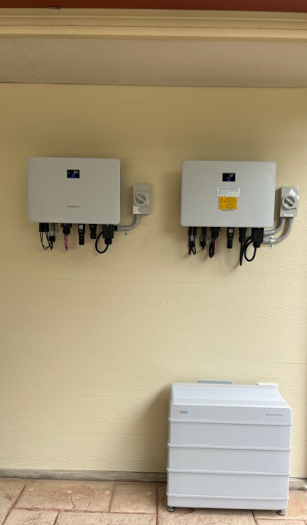
A nice little Sungrow install with solar inverter on the left, hybrid on the right and 3 battery modules. You can see why there is now a cover being supplied to hide the mess hanging off the inverters.
BYD
The battery of choice for Fronius Gen24 hybrid inverters.
Most grid-connect BYD solar battery installs in Australia are paired with Fronius hybrid inverters. As far as I can tell, the Fronius Gen24 is still a well-regarded unit, but a 40-second delay in changeover time to backup mode may cause the customers to shy away. And the work and space required in the switchboard to make a “backup box” for the off-grid functionality has some installers rejecting this solution too.
I don’t understand why Fronius haven’t developed an off-the-shelf solution instead of relying on external suppliers to fill the niche.
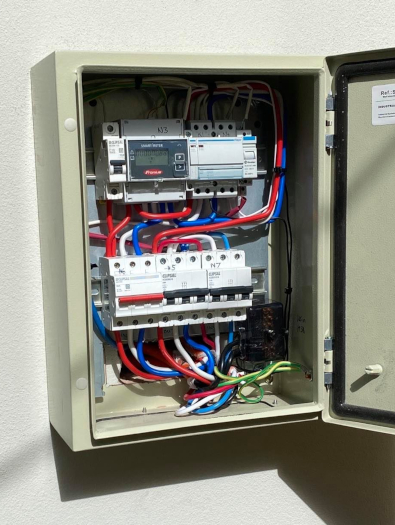
A beautifully built 3-phase Fronius backup box from Joondalup Electrical
Other Battery And Hybrid Inverter Brands
GoodWe seem to have a solid reputation as an up-and-comer, (except the Homekit smart meter…) as well as the budget Huawei Luna offering, which has a few technical features even the premium SolarEdge battery doesn’t offer.
Enphase enthusiasts are still waiting for the second coming of the Enphase battery, but sadly it looks look like it will be low capacity and high price. Again.
Curiously, Qcells batteries haven’t made much of an impression with the installers I spoke to. That’s despite Qcells offering some really strong, well-framed panels and a 15 year battery warranty.
If you’re new to all of this discussion, it might be worth reading back on some of the articles we’ve published previously, and casting an eye over our battery comparison table; which we do our best to keep up to date.
DC Coupling Isn’t Dead
Ten percent of my compatriots expressed interest in having DC coupled hybrids; mainly because they can allow you to push past limits imposed by DNSP connection agreements. As outlined above, SolarEdge allows you to run 200% solar PV to rated inverter capacity. They are more efficient because there are fewer inverters, fewer conversion steps, and less heat generated between DC and AC and DC again.
However, they also attract STC money on full manufacturer spec because they yield more. The AC inverter can handle a full 5kW going to the grid or AC loads, while the remaining 5kW of DC solar can charge the battery simultaneously. It can both walk and chew gum.
There’s still a place for low-voltage batteries
Low-voltage DC coupling with a system based on 48 volt nominal batteries can be set up to have almost infinite amounts of generation coming from your roof. Using a DC regulator and strings of panels up to 450 volts to charge your battery is a traditional off-grid way of doing things. You’ll need the right battery, a properly configured system and the best inverter to make it work well though.
Battery Support Is Critical
If you’re looking at buying a solar battery, it’s worth asking your installer how well-supported the product is and whether they’ve had to manage a warranty claim. These are all new products. I remember not many years ago when home battery suppliers didn’t have consistent terminology or definitions on how to even offer a warranty. Years? Cycles? Kilowatt-hours? it was all in the air.
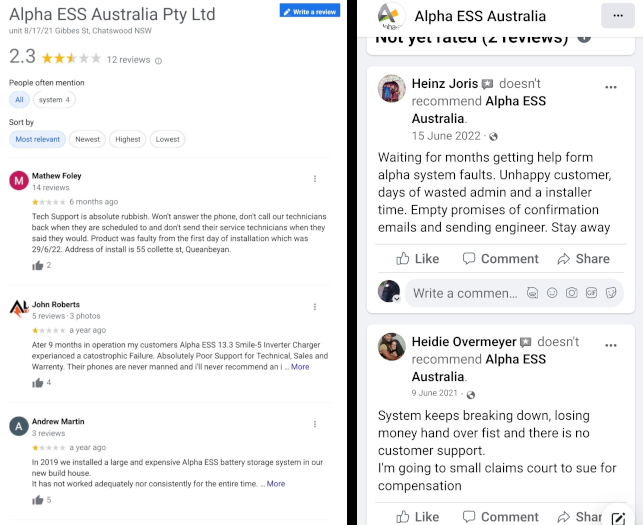
The jokes write themselves. Reviews are polarised, but there’s not much nuanced mid-range feedback for an Alpha ESS. Either you have 5 star happy comments from cheap enthusiasts or more detailed stories of buyer’s remorse.
Plan for the worst, and you may be pleasantly surprised, but don’t go looking for a warranty on a Growatt battery. They don’t publish one and won’t send you any documentation if you ask for it. I’ve prodded them via email and it turns out they simply don’t furnish warranty information. The response was as follows :
Our batteries are guaranteed for 10 years by default and the claim procedure is same as the inverter.
Unfortunately, we do not have the documentation on out website. Becuase (sic) we only sell products to the distributor or installation company. Normally, when the inverter or battery is faulty, the customer will contact the distributor or us, after our examination we will process the warranty claim.
Thanks for your advice, we will add more information on our website in the future.
Thank you for contacting Growatt Australia.”
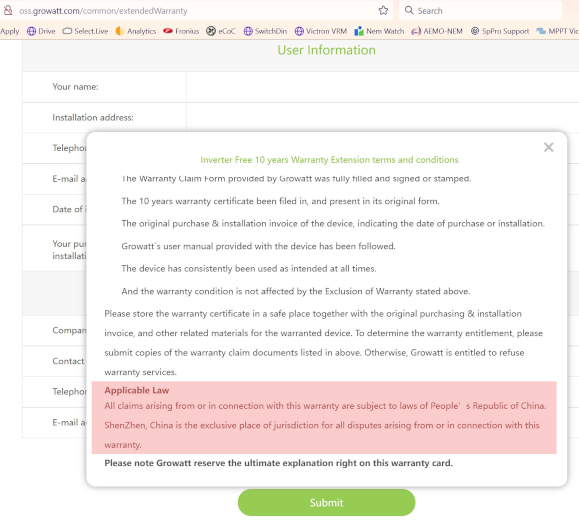
I wonder what Australian Consumer Law would have to say about this warranty?
With Home Batteries, Reliability Is King
Reliability is king. For the customer and the installer, the last thing you want is phone calls, return visits, problem-solving and parts swapping. That’s part of why I insist on changeover switches, so end-users can bypass a system if it goes pear-shaped. Being in the dark when you bought a solar battery to avoid blackouts is a terrible outcome that ruins reputations and sours relations.
It seems the battery industry has settled on 10 years as a default warranty. We are all hoping that they don’t begin the “race to the top” by differentiating themselves with longer warranties. That approach already makes solar panels warranted for 40 years look a little ridiculous.
What I think would be great is a solar battery standard to test against. Like they have fuel consumption guides for cars.
Having read all the product brochures and technical specifications and then searched out and drilled down into warranty documents until my eyes bled, it’s mind-numbing how many differences there are. Although we have a nice big table on SQ, it makes comparisons like this one on AC batteries a difficult undertaking.
Read the full results of the SolarQuotes Installers’ Choice Awards for the best home batteries in 2023 here.

 RSS - Posts
RSS - Posts



Hmm? I am about to have a Powerwall installed but have 2 inverters one 3 and a 4kW on single phase in the Ausgrid area? Problem?
Ausgrid allow you to have 10kW solar inverter capacity and 10kw AC coupled ESS so you will be ok
Thanks.
I just had a Sungrow SH10RT installed today and it didn’t come with a cover to hid the mess of cables hanging down from the inverter. I see in the image you commented that they now come with covers. Do you have any details on that cover I could ask my installer about? Battery install of the Sugrow SBR160 happening on Friday so there will be even more cables to hide then :).
Thanks
I’m considering having an SH10RT installed, and, while googling that model, kept getting served ads for these covers. Can’t vouch for them or anything, but it might give you some idea of what is out there:
https://covermyinverter.com.au/product/sungrow-inverter-cover-three-phase-rt-series/
Hi Andy,
My understanding is that Sungrow now come with the black plastic cover for the bottom but maybe not everyone has the latest stock? It might be worth a call to Sungrow to ask.
And if you have yours outdoors, then the covers Joh mentions are a great idea.
Trying to find rules/guidelines on DIY battery solutions, which are at least 3-4 times cheaper. Gen24 units (obviously not a supporter configuration) can even apparently directly connect to Tesla/ Leaf batteries with a raspberry pi doing some translating between the BMS and the inverter. Used Tesla ~70kw battery for $5k sounds pretty appetizing but want to do it by the book ( if it’s been written yet).
I admire the resourcefulness you see in the lead acid bank in the header image, we really need to be able to make better use of things that aren’t perfectly new, but your insurance company won’t view it in the same light.
Unless it’s installed with deference to AS-NZS-5139-2019, you’ll have a hard time getting anyone with a license to touch it, and those enthusiasts who aren’t licensed are often a dunnig-kruger danger to everyone, because they don’t even begin to know what they don’t know. (and if you point that out you’re just a stooge for big electrical man!)
The rules around batteries are pretty stringent and we have some explanation in this handy article as well as this informative piece from Renew.
My advice is that if you want to pick up some used EV calls and do some hacking then start with the appropriate standards and enrol with someone like GreenRTO to do as much solar design as you’re able, bearing in mind that some training is only open to qualified electricians or engineers.
Beyond that build a proverbial brick sh!thouse in the yard and make sure there are labels all over it so that the fire services know what to do if you’re not home and the battery system is billowing smoke.
Some people haven’t been so cautious and they’ve reapt the consequences sadly. These events are a sobering reminder that you shouldn’t put others at risk for the sake of a few dollars.
The other option, which still seems years away (particularly for Vic) is getting a car with proper V2L / V2G and a bidirectional charger. That way the battery can stay in the car and I assume I won’t’ have to go through years’ worth of electrical training / paperwork just to sign off on it being safe. Downside there is obviously price, but you do get a car out of it!
If you’re at the bleeding edge then bi-directional charging is already here, and indeed your 40kWh – $40k battery does come with a free car, however some are resorting to a car charger and a vehicle with V2L capacity. I think a Kia EV6 has a 3.6kW inverter on board but there are more complexities to deal with if the EV has an earth leakage safety switch that disagrees with the MEN in your house switchboard… stay tuned for a quick FAQ on that matter.
We have a BYD 13kw battery on a Fronius Symo Gen 24 as part of a 22Kw 3 phase system. I went with the BYD because of the seamless link up with the Fronius and because I wanted to export 15kw when I had excess power. We also have a Fronius Wattpilot Go 22Kw. The DC pass through function seems to work really well and the battery recharges very quickly. The charge rate increases as you get more cells in the battery but the discharge rate is limited to the Inverter it is connected to, in our case 10kw. We have two inverters but only one Gen 24 because of the complexity of connecting two Gen 24 and batteries to the grid. Start thinking about a 96 slot fuse box. The 20 sec lag is a bit of a drag but I have a UPS to take up some critical slack. I wish there was a one box grid interactive battery in line system for a 3 phase system. The Selectronic option is far too expensive on 3 Phase.
I have a legacy system probs 15 yo. Is there a system or service that that I can access to review what options I have in terms of system component capacity and add ons without losing legacy 45c rebate rates and breeching the DNTS limits.
Justin – any kind of upgrade to the system will result in a loss of your premium tariff. See here: https://www.solarquotes.com.au/blog/upgrade-replace-solar/
Will Fronius Primo with Powerwall 2 work in islanding mode?
Yes certainly Jeff, one of our notable contractors here in Adelaide does Fronius & Powerwall combos almost exclusively.
Thanks Anthony
How much load and for how long can a tesla battery and inverter deliver. Could it for instance work a pressure pump or dryer, dehumidifier and air conditioner without grid power at night for normal use provided the inverter was of sufficient capacity?
Richard – see specs here – “Real Power” is the relevant one: https://www.tesla.com/sites/default/files/pdfs/powerwall/Powerwall%202_AC_Datasheet_en_AU.pdf
So you have 5kW to play with. If your pump/dryer/dehumidifier/aircon, when all on at the same time, pull less than 5kW – you’ll be golden. Any more than that – and the grid will step in.
Hi Anthony, Does it matter what inverter you use? I am very concerned that Huawei is Chinese Government owned.
Hi Andy,
The best way to avoid your concern would be an Australian made Selectronic SpPro, some PowerPlus batteries and a Fimer or Fronius solar inverter. Expensive but the very last word in reliability and bolt honest lack of complexity compared to any modern high voltage hybrid.
Or get your self a Fronius hybrid perhaps. All of the “affordable” options will be more or less from China.